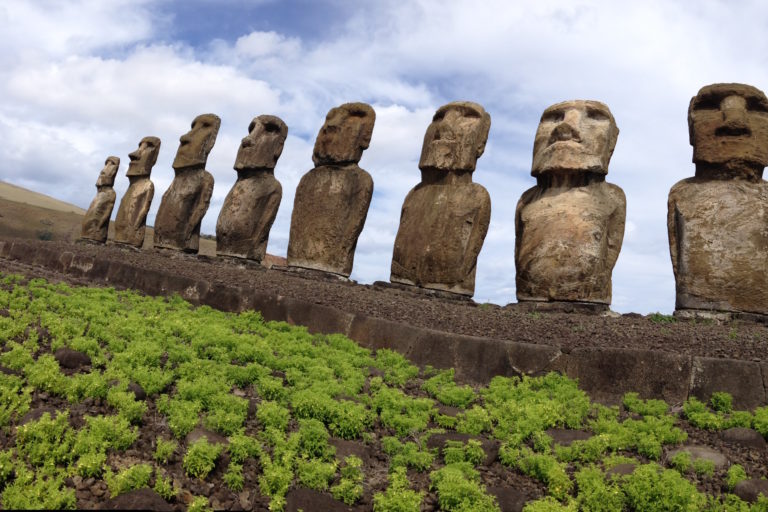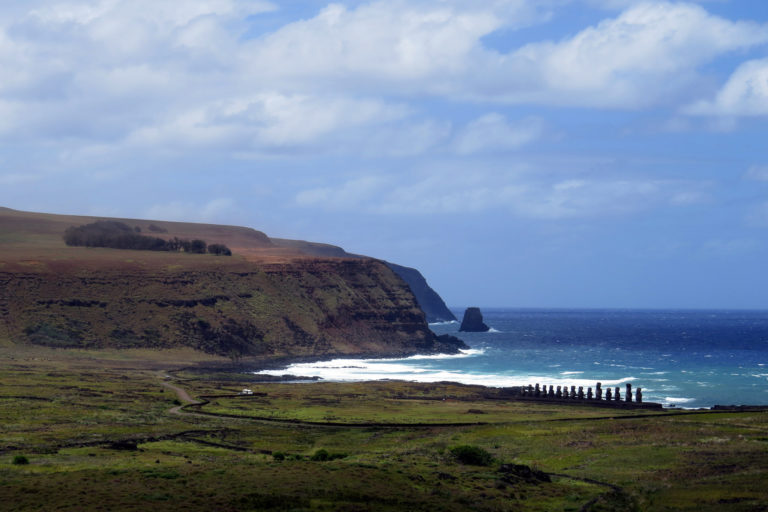
Rapa Nui National Park, created in 1966, was declared a World Heritage Site by UNESCO in December 1995. Image by Claudio Lobos.
In Chile, Rapa Nui (also known as Easter Island), includes two protected areas. First, the World Heritage status Rapa Nui National Park, which focuses on the legacy of Rapa Nui culture, including its renowned stone statues. Second, the Rapa Nui Marine Protected Area, which encompasses 740,000 square km2 (286,000 mi2) of Pacific Ocean surrounding the island.
In February 2019, Mongabay’s Spanish-language news bureau, Mongabay Latam, published an article exposing corruption of Rapa Nui National Park’s management. This prompted widespread media coverage that spurred and informed actions to address the situation.
About 360 million pesos had been diverted to companies and the family of former chairman of the park’s board of directors, Camilo Rapu. The conflict divided residents of Rapa Nui, resulting in a mob beating and a courtroom set on fire, and sparked ongoing investigations by Chile’s public prosecutor’s office.
The Chilean government transferred the management of the national park to the Ma’u Henua Polynesian Indigenous Community in 2018. By then, however, there was already conclusive evidence of serious financial inconsistencies in the park’s provisional management by Ma’u Henua’s board.
Mongabay Latam was the first media outlet that investigated this instance of corruption and fraud. The effort included collecting testimonials, publishing documents, and requesting the cooperation of public servants to unveil the serious financial and administrative practices that were affecting Rapa Nui National Park. Mongabay kept the issue within the public eye with several articles further detailing the status of the scandal and Rapu, who is currently being investigated by the Anti-Corruption Unit of the Public Ministry. Since the first article was published, Mongabay has released three other articles:
- Conflicto en Rapa Nui: se acumulan denuncias contra la administración del Parque Nacional;
- Chile: la belleza de Rapa Nui es contaminada por escándalo de corrupción;
- Fiscal meltdown at Easter Island park drives rift among islanders.

Fire engulfs the Easter Island courthouse on Jan. 29, 2019. Image by Tamaru Huke.
How journalism informed action
Mongabay’s investigation was republished by some of Chile’s most well-known news outlets, such as Bio Bio, El Desconcierto, El Mostrador, Rapa Nui Press and El Libero.
Following the media exposure, Rapu was removed from office a month after Mongabay’s first article on the matter in March 2019. Furthermore, the article was included as evidence in the complaint that Rapa Nui community members sent to the prosecutor’s office.
Representatives of the 36 families of the Rapa Nui territory told Mongabay Latam that “The information provided by your journalists allowed us to initiate legal actions, which seek that those involved in these bad practices respond judicially.”
Three months after the initial publication, the district attorney confirmed to Mongabay Latam that five new charges had been filed against Rapu’s administration. These include promoting public disorder, misappropriation, threats, and usurpation, all of which are still being investigated by Rapa Nui’s district attorney.

Rapa Nui. Image courtesy of SNASPE-CONAF.
Support independent environmental journalism
If you are interested in helping shed light on conservation stories such as this one, there are two excellent ways you can do so with Mongabay. First, consider making a donation, which directly helps us continue to produce high impact journalism from nature’s frontline. Second, subscribe to Mongabay’s newsletter to get the latest environmental news delivered right to your inbox.
About Mongabay
Mongabay is a nonprofit environmental science and conservation news platform focused on providing cutting-edge independent journalism from nature’s frontline. We pride ourselves in producing reporting that has substantial, tangible impacts around the world.